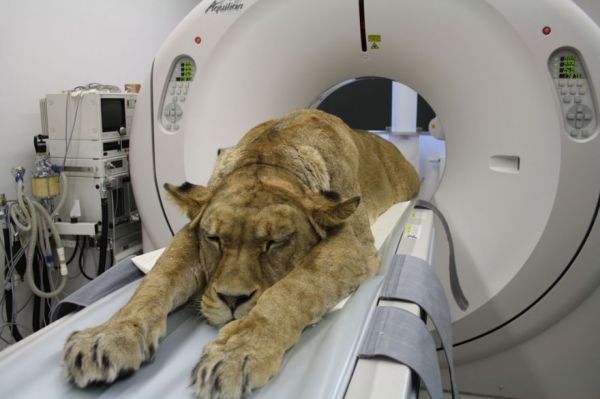If the
legendary romance of hopping railroad trains appeals to you (or to your child), browse the photo gallery at the top of this Reddit thread.An article in
Detroit News
emphasizes that computers in cars can be wirelessly hacked. "Markey
cited studies showing hackers can get into the controls of some
popular vehicles, '
causing them to suddenly accelerate, turn, kill the
brakes, activate the horn, control the headlights, and modify the
speedometer and gas gauge readings...'"
Jalopnik provides an example of a 14-year-old doing so using equipment he bought for $15 at Radio Shack.
"...16-year-old Maxwell Marion Morton of Jeannette, Pa., fatally shot
16-year-old Ryan Mangan in the face before
taking a photo with Mangan’s body and uploading it to Snapchat..."
An op-ed piece at Jezebel asserts that "
Adults should not be drinking milk."
Nissan has demonstrated a
glow-in-the-dark body paint for cars. Video at the link.
An elephant with an elastic ribbon illustrates Samuel Butler's adage that "
All animals, except man, know that the principal business of life is to enjoy it."
Technology is significantly
changing the experience of consuming marijuana.
"While refining marijuana requires skill, caution, and an elaborate
setup, concentrates will likely prevail. They’re simply a more economic
THC-delivery system."
The Weather Channel's Jim Cantore
really REALLY loves thundersnow.
Diane Rehm, host of a nationally-broadcast NPR program, adds her
remarkable voice to the right-to-die debate after her husband, unable to
get medical assistance to die,
starved himself to death. “I feel the way that John had to die was just totally inexcusable,” Rehm
said in a long interview in her office. “It was not right.”
The image at right is a graphic portrayal of an
analysis of 1.3 trillion hands of Texas hold-em poker. Details at the link, where the process is interactive.
Divers are
retrieving a historic typeface from the bottom of the Thames, where it was dumped a century ago.
A
carnivorous plant
has been identified in 40-million-year-old amber. It had not developed
digestive enzymes, relying instead on a symbiotic relationship with an
insect.
A
hoard of thousands of gold coins in in different denominations has been found in the Mediterranean off the coast of Israel.
Video of a man
sliding down a mountain on his butt while being chased by his snowmobile.
From the Boston Globe, a
gallery of 35 photos of the record snowfall in New England.
Oliver Sacks has written an article about his discovery that his ocular melanoma is metastatic and therefore terminal:
"I
feel a sudden clear focus and perspective. There is no time for anything inessential. I must focus on myself, my work and my friends. I
shall no longer look at “NewsHour” every night. I shall no longer pay
any attention to politics or arguments about global warming. This
is not indifference but detachment — I still care deeply about the
Middle East, about global warming, about growing inequality, but these are no longer my business; they belong to the future."
Rebuttal of the claim that
climate-change data was falsified.
While in jail,
a man punches himself in the face to get black eyes in attempt to claim that he was beaten by police; his self attack is captured on video.
A lucid
explanation of the Roswell incident.
An article about a planned
upgrade of the Panama Canal.
And a reminder that when you sail from the Atlantic to the Pacific
through the canal, you are traveling east, not west (a good pub-quiz
question).
A "
lost Sherlock Holmes story" has been found. It's not all that great, but enthusiasts will want to read it (fulltext at the link).
A man looking at watches in a Goodwill store in Arizona
paid $6 for one that he was able to sell for $35,000.
Full sunlight provides about 10,000 lux of illumination. Human eyes can
see in light as dim as 1 lux. Cats = 0.125 lux. Tarsiers = .001 lux
(and shame on people who photograph them with flash illumination). A
BBC article lists three creatures with even more sensitive eyes (able to see at illumination levels of .000063 lux).
Some people
object to their neighbors putting up Little Free Libraries. "Americans with Little Free Libraries are acting in that venerable
tradition. Those exploiting overly broad laws to urge that they be torn
down are a national disgrace."
Here's a good website:
Old and Interesting. Go look for yourself.
I find John Oliver's sense of humor to be sometimes annoying, but one
can't deny the power of some of his arguments, especially this
discussion of
how American judges are elected.
The graph depicts
penis size
based on 15,000 measurements of men around the world. It's an awkward
depiction; I think if the data were regraphed, it would be more
understandable as a bell-shaped curve. And when the article states that
"In reality, only 2.28% of the male population have an abnormally small
penis... and the same percentage an unusually large one," that's because
"normality" is defined in that way - to include 95% of the population.
More discussion
here.
Deep injection of wastewater causes earthquakes.
A useful webpage from the University of Minnesota discusses how to prevent and how to treat a
frozen septic system.
In an embarrassing attempt to get better positioning for postseason play,
two high-school girls basketball teams tried to lose a game,
missing free throws on purpose, failed to cross the half-court line in
time, even pointed out to the officials that they were violating the
3-second rule in the lane. Both schools were banned from the playoffs.
Here is the
full-text lyrics of 99 Bottles of Beer on the Wall. I didn't know there was a 100th verse: "No more bottles of beer on the wall, no more bottles of beer.
Hakim Emmanuel, an amateur bowler in Brockton, Massachusetts,
rolled a perfect 900 series. Video of his final frame at the link.
How conservative was Ronald Reagan? Compared to 10 of today's Republican presidential hopefuls - not very. He would only be in 5th place.
Some parents try to
treat their children's autism by "giving the children enemas,
using a dangerous industrial solution used for bleaching wood pulp...
Miracle Mineral Solution is the brainchild of Jim Humble, who quit the
Church of Scientology to form the Genesis II Church of Health &
Healing in order to promote his “miracle” cure..."
"
Strawpedoing" is how students guzzle beer without creating a vacuum in
the bottle. It looks like the straw is coming out his nose, but it's
just bent at his lips,
A record drought is
drying up the water reservoir for São Paulo.
"Kalaripayattu is considered to be the oldest fighting system, and
the urumi — a flexible whip-like sword — is its most difficult weapon to
master. An urumi wielder requires great agility and knowledge of the
weapon simply to avoid self-injury." (video at the link)
A freshman basketball player for Florida State
scored 30 points in the final 4:38 of a game. "Rathan-Mayes
scored 26 consecutive Florida State points without missing a shot." His team still lost.
A
police officer does not always have to show you his identification. Exceptions include if it would jeopardize an investigation, hinder a police function, or if safety is involved.
In 2004 the New Jersey State Department of Environmental Protection
initiated a lawsuit against Exxon Mobil Corporation for $8.9 billion in
damages for the contamination and loss of use of more than 1,500 acres of wetlands, marshes, meadows and waters.
The suit has been quietly settled by the state for around $250 million.
Also "If the settlement is completed, it is possible that some or even
none of
the money would go toward environmental costs in the Exxon case: An
appropriations law in New Jersey allows money beyond the first $50
million collected in such cases in the current fiscal year to go toward
balancing the state budget."
LARP is "
live action role playing."
The United States may have an
oversupply of people with PhDs. "...only one in five PhDs in science, engineering and health end up with
faculty teaching or research positions within five years of completing
their degrees." One reason:
postdocs are cheap labor for research labs.
A discussion thread asks truck drivers "
what town or city do you refuse to stop in?"
If you are
ordering airline tickets online for international travel, read this link about how to secure lower fares.
Video of 80-year-old Natalie Trayling giving a
remarkable 30-minute impromptu performance on a library piano of a piece of music she made up on the spot.
A photo gallery of
regrettable tattoos.
"St. Pauli pinkelt zurück." Video explains how the application of superhydophobic materials to walls
causes streams of urine to rebound onto the malefactor.
How women have used cannabis
in years past to ease childbirth, to treat swollen breasts, for
migraine, and for menstrual pain (Queen Victoria in the latter
category).
The United States' policy of birthright citizenship encourages
"maternity tourism" by Chinese women.
Use this site to "
play with gravity."
Each click generates a center of gravity that affects the moving
points. Gravity sites close together will coalesce. If all the moving
points coalesce in the gravity site, it "explodes."
The top image is a modern reworking of a classic Normal Rockwell painting.
A "chugger" is a portmanteau term for a "
charity mugger."
NASA now reports that not only did Mars once have water, but that there was probably a vast
ocean covering a fifth of the planet.
Prenatal genetic testing of a fetus sometimes reveals information that
the mother has cancer:
"...scientists from Sequenom said they have seen more than 40 cases in
which
the test revealed an abnormal genetic profile suggestive of cancer in
the mother. At least 26 of these women were subsequently confirmed to
have cancer... If she has cancer, then tumor cells may leak their DNA —
lousy with chromosomal defects — into the bloodstream..."
An easy way to make a
heart-shaped cake (see pic at right)
Photos of a
snow-covered bald eagle brooding her eggs.
Planthopper nymphs are totally bizarre-looking. (Very brief video at the link)
Nestlé will only have to pay the Canadian government less than $600 per year for the use of
265,000,000 liters of groundwater.
The
bird collection of Oslo's Natural History Museum is now available online.
The term "
worry wart"
became popular as the result of being used in a comic strip. "... it
didn’t mean what it does now — somebody who constantly worries about
everything and anything. Instead it took its sense from the cartoon — a
child who annoys everyone through being a pest or nuisance."
"
Vog" is a combination of fog, smog, and volcanic gas.
Lindsey Graham
has never sent an email.
Florida Department of Environmental Protection officials "have been ordered
not to use the term “climate change” or “global warming” in any official communications, emails, or reports,
according to former DEP employees, consultants, volunteers and records
obtained by the Florida Center for Investigative Reporting."
For a brief introduction to The Illuminati, The Bilderberg Group, the
Trilateral Commission, the Skull & Bones Society, and Bohemian
Grove, see
The Paranoid's Guide to Secret Societies.
A series of seven maps illustrates
how Ukraine evolved into its present geographic arrangement.
Anyone who has had the privilege of eating at
Betty's Pies on
Minnesota's North Shore (just north of Two Harbors) will want to read
this
tribute to Betty Lessard, who recently passed away.
Video of a
mantidfly.
A wheelchair-bound 5-year-old girl
scores a goal in ice hockey with the assistance of a Chicago Blackhawk.
A set of photos of the
New York apartment Lauren Bacall lived in for over 50 years.
"Dairy farmers routinely
feed their cows a finger-sized magnet, which
settles in the digestive tract to help keep the cows healthy... To check if a cow already has a magnet, farmers use a compass."
The
Export-Import Bank explained.
"
Palcohol"
is powdered alcohol. Proponents say there is no risk of people
snorting it, that it's no easier to sneak into events than liquid
alcohol, and that it's difficult to spike people's drinks with it.
Video of a 95-year-old man setting the
world record for the 200m sprint for his age group.
"Hunting competitions" are quite popular. "Some $76,000 in prize money was at stake—more than $31,000 went to the
team that bagged a 32 pound bobcat. Other jackpot winners were a
four-man team that killed 63 foxes, a team that killed 8 bobcats, and
another that killed 32 coyotes."
The famous "Patterson film" of a
walking "bigfoot" has been image-stabilized, and it's obvious to anyone viewing it that this is a man wearing a costume.
An article at
Lapham's Quarterly explains how establishments that buy your old gold and silver routinely rip off the customers.
Progressives who have mostly given up hope of getting Elizabeth Warren
to run for president against Hillary Clinton are now pondering the
possibility of
Warren as a vice-president. "Warren would bring a populist appeal to the ticket that Clinton does not possess."
Based on over 200,000 Jeopardy! questions used in the program,
the most common Jeopardy! response is "What is China?"
In Double Jeopardy, it is "What is Australia?" The most common category in Final Jeopardy! is "Word Origins."
"The
White House is removing a federal regulation that subjects its Office of Administration to the Freedom of Information Act, making official a policy under Presidents Bush and Obama to reject requests for records to that office."
Members of a University of Michigan fraternity partying at a ski resort caused an estimated
$400,000 of damage. "There was damage to 45 rooms, and students destroyed ceiling tiles and
exit signs, broke furniture and doors and urinated on carpeting."
A 26-minute video nicely explains the
unique environmental features of the "driftless zone" in the Upper Midwest.
Was the plane crash that killed UN Secretary General
Dag Hammarskjold an assassination? Was it engineered by agents in the United States and Europe? The UN is reopening an investigation.
Why is insulin so expensive in the United States. "Greene decided to
call some local pharmacies, to ask about low-cost options. He was told
no such options existed. Only then did I realize
there is no such thing as generic insulin in the United States in the year 2015," he says.
Browse all 600 pages of the
JC Penney 1982 Christmas catalogue.
demantoid garnets
While garnets have been known since ancient times, the demantoid variety
was not discovered until 1868 in Russia's western central Ural
Mountains. From the time of the demantoids find until about 1919, they
were popular in Russia as the famous Peter Carl Fabergé made jewelry
with them.
***
Man, that felt good and now our trousers fit better!













 Wu
Zhao was born in 624 into a noble and wealthy family, and was educated
from an early age in music, art, literature, and philosophy. That
education would help her immensely. When she was 13 years old, her
family’s connections allowed her the great privilege of becoming a Cairen,
one of nine “fifth-tier” concubines of the Emperor Tai-tsung. Her
education, her musical talent, her beauty, and her wit made her stand
out from the other girls, and she soon became one of the emperor’s
favorites. He gave her the title Meinang, or “Charming Lady,”
and assigned her to work in the imperial study. There she would add to
her knowledge the workings of government- knowledge that she would put
to great use in the coming years.
Wu
Zhao was born in 624 into a noble and wealthy family, and was educated
from an early age in music, art, literature, and philosophy. That
education would help her immensely. When she was 13 years old, her
family’s connections allowed her the great privilege of becoming a Cairen,
one of nine “fifth-tier” concubines of the Emperor Tai-tsung. Her
education, her musical talent, her beauty, and her wit made her stand
out from the other girls, and she soon became one of the emperor’s
favorites. He gave her the title Meinang, or “Charming Lady,”
and assigned her to work in the imperial study. There she would add to
her knowledge the workings of government- knowledge that she would put
to great use in the coming years. 










